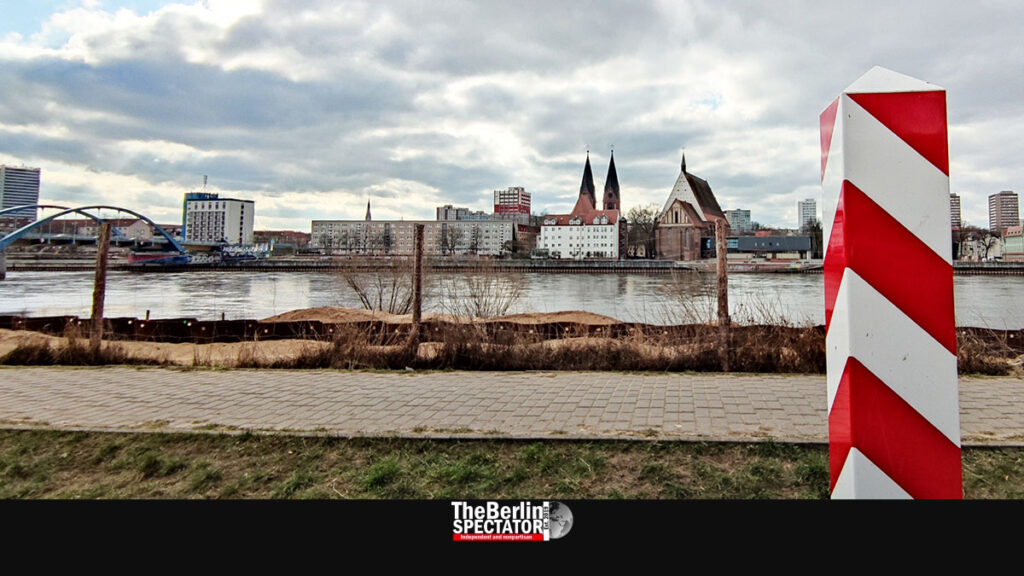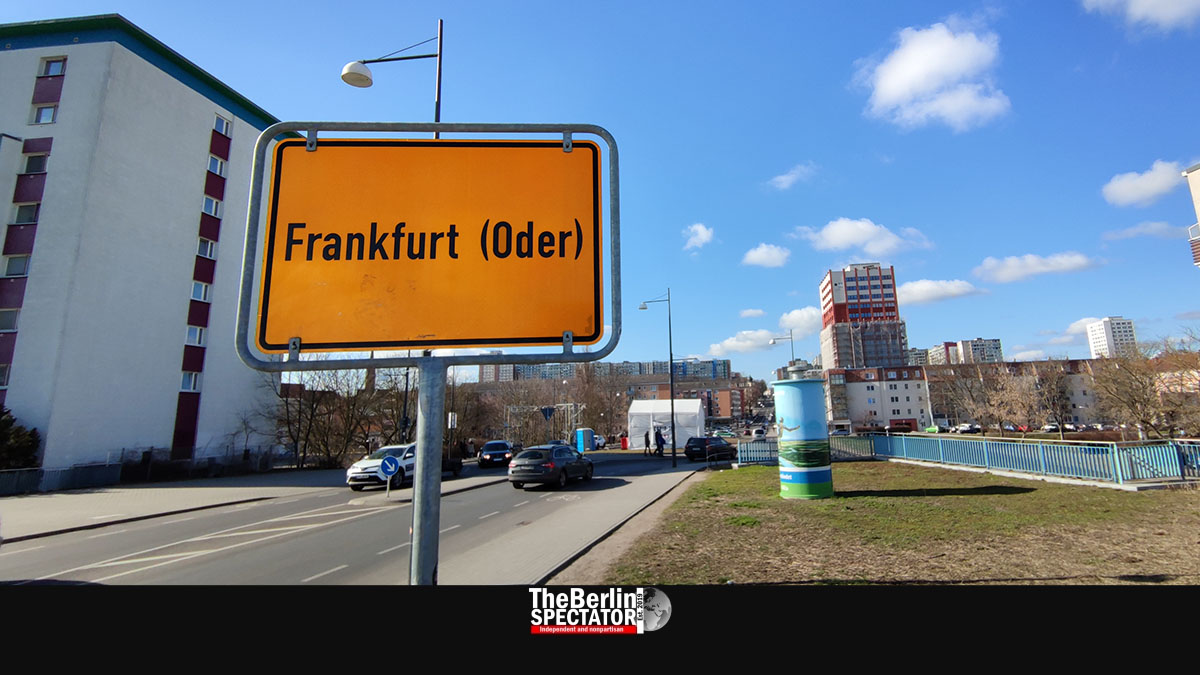Our reporter went to Frankfurt. What he saw there should not have surprised him, but it did. Then, he ended up at the ‘Polish Market’ in neighboring Słubice.
Berlin, March 11th, 2022 (The Berlin Spectator) — When you get to Frankfurt, you will have to look for the banking quarter for a long time, because it does not exist. Try to order a Green Sauce meal at any restaurant there. They will not have the faintest clue what you are talking about and laugh at you. Where in the hell is the Main river? What about Frankfurt Cathedral? And what happened to Frankfurt Airport? If this is what you are asking yourself, you are in the wrong Frankfurt.

Frankfurt or Frankfurt
The two Frankfurts are 613 kilometers (381 miles) apart, from city center to city center. If you kick it, you will make it in six and a half hours via Potsdam, Leipzig, Jena and Erfurt or the other way around, depending on whether you are in Frankfurt or in Frankfurt. In case someone asks you which Frankfurt you like more, just say “Frankfurt”. It drives them crazy.

So, what is the difference? Everything is. Frankfurt am Main has some 750,000 inhabitants, while Frankfurt (Oder) has 57,000. In the latter city, the extremist right-wing party ‘AfD’ is very strong. In the western Frankfurt, it got around 5 percent. The two cities are opposites in many ways. This is like comparing Nutella sandwiches to sharks or washing machines to the Moon.

Grey and Decayed
When you approach Frankfurt (Oder), the right attitude is important. To be honest: I expected to see as much decay as I had encountered there during my last visit thirty years ago. I thought the sky over there was always grey and the smell of brown coal would hit me. This arrogant ‘Wessi’ approach (‘Wessi’ as in ‘westerner’) was unnecessary and inappropriate. I admit it. What I saw was a nice and sort of green city with neat buildings under a sunny sky.

The Oder river is not only Frankfurt’s eastern city limit, but also the German-Polish border. Before the Allies defeated fascist Nazi Germany in 1945, Frankfurt had a borough on the eastern side of the river. It was called Dammvorstadt. Today, this place is the Polish town of Słubice with some 17,000 residents. It is connected to Frankfurt by Frankfurt City Bridge which got its name because it used to connect Frankfurt’s two parts.

Schengen States
A lot of traffic moves back and forth between Słubice and Frankfurt during the day. Every 15 minutes, the German customs appear. Four to six officers park their vehicles on the grass next to the bridge and look at the vehicles that drive by, and their number plates. Drivers or cars that look suspicious will be pulled out and checked. The frequency at which they do those checks is surprising because this is supposed to be an open border between two Schengen states, meaning anyone is allowed to cross it and bring along any legal merchandise.

One thing is certain: The Frankfurters do more shopping in Słubice than the Słubicers do in Frankfurt. In the small Polish town, the gas stations are always crammed these days. That is because the Polish state decreased the VAT on gasoline substantially due to the high oil costs that lead to exaggerated fuel prices. Last weekend, a liter of Diesel in Słubice was 1.36 Euro (1.49 Dollars or 1.14 Pounds), while it cost above 1,90 Euro (2.09 Dollars or 1.59 Pounds) in Frankfurt. This was shortly before the prices skyrocketed further, to all-time highs. Even Berliners drive those 100 kilometers to Słubice to fill their fuel tanks.

Haircuts and Cigarettes
While they are there, they can just as well get a haircut for half the price or visit the ‘Polish Market’ on Highway 29, just south of Słubice. At this location, they can get cheaper cigarettes, inexpensive clothing and a full meal for 9 Euro (9.89 Dollars or 7.55 Pounds), but its quality is mediocre. Last Saturday, a guy at the grill kept on touching each piece of meat with his bare hands, the Schnitzel was a bit greasy and the mashed potatoes I had ordered looked a lot like French fries. Besides, nothing they offered at the market was attractive. A lady from Słubice told me, the prices at the ‘Polish Market’ were actually higher than in town. According to her, Poles do not go there unless they are merchants.

So, it was time to get back across the Oder, to Frankfurt. At its tiny train station, dozens of Federal Police officers were busy because Russia’s war against Ukraine caused an enormous flood of refugees. At this point in early March of 2022, ten thousand Ukrainians and persons of other nationalities who lived in Ukraine until Vladimir Putin attacked it were coming to Berlin on Polish trains, all of which stopped at this station, every day. Hardly any of the refugees got off in Frankfurt though, which is why the three volunteers on site were not nearly as busy as the cops who checked everyone’s passports or ID cards.

Interesting Contrast
The best part is a walk through Frankfurt’s city center. At City Bridge, the ‘Friedensglocke’ (‘Bell of Peace’) is a symbol of the German-Polish friendship. It was placed there in 1952, only thirteen years after Nazi Germany attacked Poland. A few steps away, the beautiful Concert Hall is a former church. It was named after Carl Philipp Emanuel Bach, one of Johann Sebastian Bach’s sons, and fits on one photo with part of the neighboring ‘Friedenskirche’ (‘Church of Peace’).

An interesting aspect is the fact that the communist GDR built its typical apartment blocks right next to churches and other historic buildings, which was a mistake. But this contrast is actually interesting today. Of course, we can see the same thing in Potsdam and many other eastern German cities.

Merchant’s Settlement
The Oderturm (‘Oder Tower’) was erected by the GDR in 1976. It is the pride of the city and makes it look bigger and more important than it actually is. Located across Karl Marx Strasse, the Lenné shopping mall is ugly, but the Lenné Park behind it is not. Nor is all the other greenery in this city. ‘Der Anger’ is a nice spot too, just like the alameda next to it.

In or around the year 1200, a merchant’s settlement developed here at the Oder river. In 1225, it got market rights. Then, on July 12th, 1253, a town was founded at the location. Almost six centuries later, in 1811, Frankfurt lost its university, which was relocated. After Germany’s reunification, in 1991, it became a university city again when the European University Viadrina was founded there. The Nazis destroyed the synagogue’s interior during the Night of Broken Glass. In 1989, just before the GDR ceased to exist, residents protested against the mean regime in East Berlin by the thousands.
What I learned during my visit is that the “wrong Frankfurt” is actually the right one, just like the other Frankfurt. They are both “right”, but very different.


